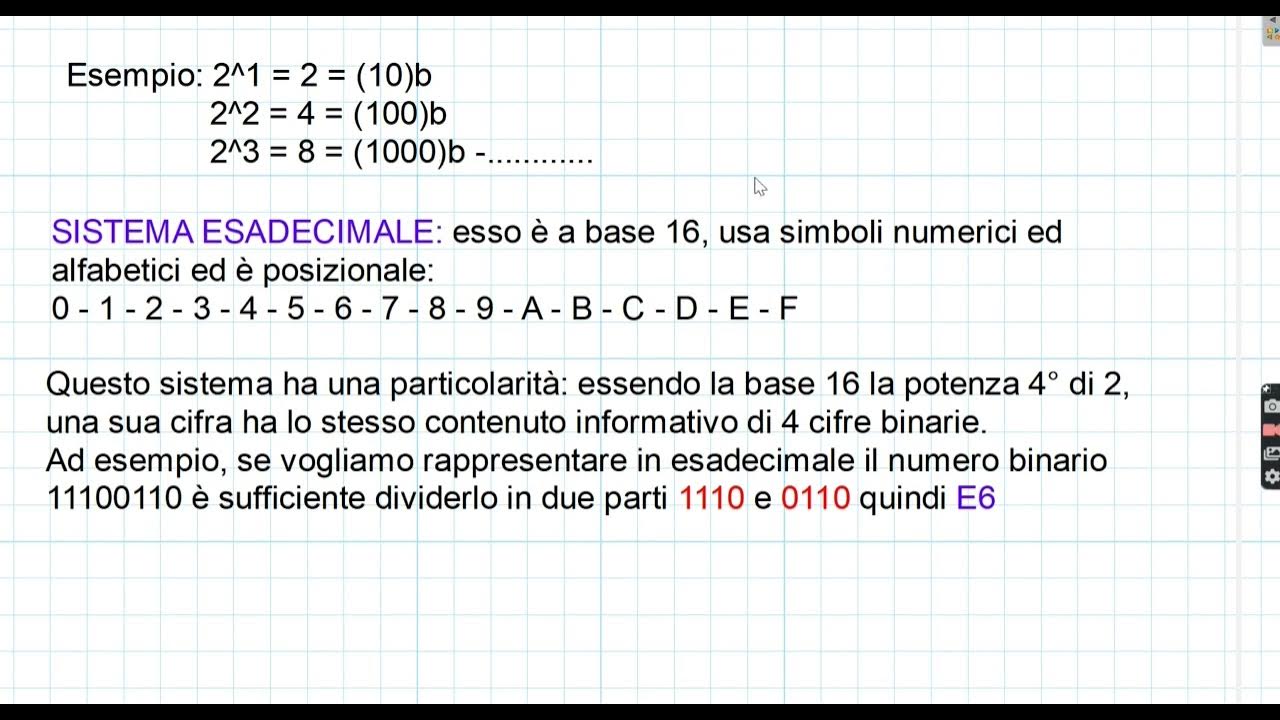Binary Math - CompTIA Network+ N10-005: 1.3
Summary
TLDRThis video explains the fundamentals of binary math, focusing on the conversion between binary and decimal systems, crucial for subnetting. It covers how binary numbers, made up of bits, can be translated into decimal using a conversion chart, and vice versa. The video includes practical examples to demonstrate the step-by-step process, like converting 1 000010 to 130 and 1111 1111 to 255, as well as converting a decimal number like 154 into binary. Understanding these conversions is vital for tasks like subnetting in networking, where binary and decimal are frequently used to define IP addresses and network ranges.
Takeaways
- 😀 A binary bit can only be either 0 or 1, representing an on/off or hot/cold state.
- 😀 Binary numbers are grouped into sets of 8 bits, known as bytes or octets.
- 😀 Understanding the binary-to-decimal conversion process is crucial for subnetting in networking.
- 😀 A simple conversion chart helps visualize the relationship between binary bit positions and their decimal values (1, 2, 4, 8, etc.).
- 😀 To convert a binary number to decimal, add the decimal values where the binary digits are 1.
- 😀 For example, the binary number '10000010' converts to 130 by adding 128 and 2.
- 😀 Converting a decimal number to binary involves determining which powers of 2 sum up to the number.
- 😀 For example, to convert 154 to binary, you break it down into 128 + 16 + 8 + 2, resulting in '10011010'.
- 😀 The range of values that can be represented depends on the number of bits—2 bits can represent values from 0 to 3, while 8 bits can represent values from 0 to 255.
- 😀 Each additional bit doubles the range of representable values, allowing for larger numbers.
- 😀 Understanding binary and decimal conversions is foundational to working with IP addresses and subnetting in networking.
Q & A
What is the difference between a binary bit and a byte?
-A binary bit is a basic unit of information that can only be 0 or 1, representing 'off' or 'on'. A byte, often referred to as an octet, consists of 8 bits grouped together. This is the standard unit used in most computer systems.
Why is the conversion chart used in binary-to-decimal calculations important?
-The conversion chart helps visualize the binary-to-decimal relationship by associating each bit with a power of 2. It enables you to easily add up the decimal values corresponding to the '1' bits in a binary number, facilitating accurate conversion.
How do you convert a binary number like '1 000010' into a decimal number?
-To convert '1 000010' to decimal, start by aligning the binary number with the conversion chart. The ones in the binary number correspond to the powers of 2, so you add the decimal values for positions where there's a '1'. In this case, 128 + 2 = 130.
What is the decimal value of the binary number '1111 1111'?
-The binary number '1111 1111' corresponds to the decimal value 255. This is because all eight bits are set to '1', representing the sum of the powers of 2 from 128 down to 1.
What is the relationship between the number of bits and the range of decimal values?
-The number of bits determines the range of decimal values you can represent. For example, with 8 bits (a byte), you can represent decimal values from 0 to 255. With more bits, the range increases exponentially (e.g., 9 bits represent values from 0 to 511).
How do you convert a decimal number like 154 to binary?
-To convert 154 to binary, you repeatedly subtract the largest power of 2 that fits into the number, marking each place where a power of 2 is used. For 154, the binary representation is '10011010', corresponding to the sum of 128 + 16 + 8 + 2.
Why does the binary conversion process involve subtraction?
-Subtraction is used to determine which powers of 2 can be subtracted from the decimal number. By identifying the largest fitting power of 2 and subtracting it, you reduce the decimal value step by step until you reach zero.
What is the total number of different permutations possible with an 8-bit byte?
-An 8-bit byte can represent 256 different values, ranging from 0 to 255. This is because each bit can either be '0' or '1', resulting in 2^8 (or 256) combinations.
What would be the binary representation of the decimal number 7?
-The binary representation of 7 is '111'. This is because 7 is the sum of the powers of 2: 4 + 2 + 1.
What happens when you increase the number of bits beyond 8?
-As you increase the number of bits, the range of decimal values you can represent also increases. For example, with 9 bits, you can represent values from 0 to 511, and with 10 bits, you can represent values from 0 to 1023.
Outlines

هذا القسم متوفر فقط للمشتركين. يرجى الترقية للوصول إلى هذه الميزة.
قم بالترقية الآنMindmap

هذا القسم متوفر فقط للمشتركين. يرجى الترقية للوصول إلى هذه الميزة.
قم بالترقية الآنKeywords

هذا القسم متوفر فقط للمشتركين. يرجى الترقية للوصول إلى هذه الميزة.
قم بالترقية الآنHighlights

هذا القسم متوفر فقط للمشتركين. يرجى الترقية للوصول إلى هذه الميزة.
قم بالترقية الآنTranscripts

هذا القسم متوفر فقط للمشتركين. يرجى الترقية للوصول إلى هذه الميزة.
قم بالترقية الآنتصفح المزيد من مقاطع الفيديو ذات الصلة

ED2. Sistemi di Numerazione

Materi Kuliah 1 - Sistem Bilangan || Pengantar Ilmu Komputer

3. CAMBRIDGE IGCSE (0478-0984) 1.1 Converting between number systems - Part 1

KONVERSI BILANGAN BINNER

Teknologi Digital • Part 1: Pengertian Teknologi Digital, Sistem Bilangan, dan Kode Biner

Tutorial Lengkap: Cara Konversi Bilangan Desimal ke Biner, Oktal dan Hexadesimal
5.0 / 5 (0 votes)
